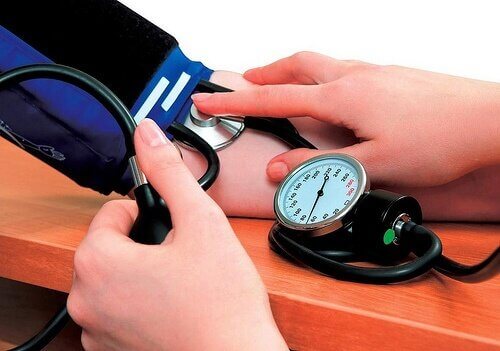What Are the Causes of Postpartum Pre-eclampsia?

Postpartum pre-eclampsia is one of the most delicate medical conditions a woman can experience. Although it isn’t common, it’s important to take proper preventative measures.
Women also need to know how to recognize the symptoms of postpartum pre-eclampsia in order to receive the right treatment as soon as possible.
Symptoms may appear immediately after giving birth and may last as long as one to three months.
“Postpartum elevated blood pressure is more frequent during the first three to six days after birth, when most patients have already been released. A significant increase in arterial pressure can be dangerous (for example, producing a cerebrovascular accident); however, there is little information on how to prevent and treat this condition.”
–Guillermo Hernández, Ernesto Deloya, Jenner Martínez, Manuel Lomelí–
To begin, we must define postpartum pre-eclampsia as an illness involving high blood pressure. The same can occur during pregnancy, in other words, prior to giving birth.
It’s important to clarify that this condition requires immediate treatment to avoid the risk of cardiovascular complications. Among these problems, we can mention damage to the blood vessels and veins as well as long-term heart conditions.
Signs and symptoms of postpartum pre-eclampsia
- Sudden rises in arterial pressure. By high blood pressure, we’re referring to readings equal to or higher than 140/90.
- An excessive concentration of protein in urine (more than 300 mg).
- Sudden and temporary loss of vision. Women may also experience hypersensitivity to light, weakness, fatigue, and altered states of consciousness.
- Sudden and noticeable weight gain. For example, one or two pounds per week, despite following a healthy diet. Nausea and vomiting may also be present.
- Swelling of the extremities and face.
- Stomach or abdominal pain.
- Painful breathing.

Causes of postpartum pre-eclampsia
Doctors and scientists still haven’t come to an agreement as to the definite cause of this condition. However, the most viable explanation is that postpartum pre-eclampsia occurs in women who suffer pre-clampsia during pregnancy – even without knowing it.
Another factor that can have to do with the occurrence of postpartum pre-eclampsia is a family history of the same medical condition.
Other risk factors include the following:
- An increase in blood pressure after the 20th week of pregnancy.
- Pregnancy that takes place in women under the age of 20 or over the age of 40.
- Obesity or excess weight.
- Multiple pregnancies.
Complications and risk factors
- This condition has symptoms similar to those of pre-eclampsia. The major difference is that it can cause episodes of convulsions and definitive damage to vital organs like the brain and kidneys. In the worst of cases, postpartum pre-eclampsia can be fatal or lead to a comatose state.
- Pulmonary embolism. This illness consists of the simultaneous appearance of two conditions: Vein thrombosis and lung embolism. When this condition occurs, individuals have difficulty breathing, chest pain, fever, and are unable to carry out a normal life.
- Pulmonary edema. This is an illness that drastically affects the respiratory systems. It consists in the accumulation of liquids in the inside of the tissues and cavities of the lungs. It’s identified by the expelling of blood when coughing, anxiety, excessive sweating, and difficulty inhaling and exhaling.
Diagnosis and treatment
- Blood tests. Blood tests help reveal if the liver and kidneys are functioning normally. They also verify that a woman has a healthy platelet count. These cells regulate the coagulation of the circulatory system and can save someone’s life in the case of hemorrhage.
- Urine tests. This type of test will indicate the concentration of protein in a woman’s urine. A concentration of more than 300 mg is a sign of alert.

When it comes to treating postpartum pre-eclampsia, it’s important to point out that, in general, it requires the use of medications. Treatment should focus on avoiding convulsions, reducing blood pressure and normalizing the urine composition.
Now you know how to identify the symptoms of postpartum pre-eclampsia and the consequences of ignoring them. Women’s bodies are more vulnerable after having a baby, which is why it’s so important we pay attention to what our bodies tell us.
Your health needs to be a priority so that you can take care of your child and your family.
Postpartum pre-eclampsia is one of the most delicate medical conditions a woman can experience. Although it isn’t common, it’s important to take proper preventative measures.
Women also need to know how to recognize the symptoms of postpartum pre-eclampsia in order to receive the right treatment as soon as possible.
Symptoms may appear immediately after giving birth and may last as long as one to three months.
“Postpartum elevated blood pressure is more frequent during the first three to six days after birth, when most patients have already been released. A significant increase in arterial pressure can be dangerous (for example, producing a cerebrovascular accident); however, there is little information on how to prevent and treat this condition.”
–Guillermo Hernández, Ernesto Deloya, Jenner Martínez, Manuel Lomelí–
To begin, we must define postpartum pre-eclampsia as an illness involving high blood pressure. The same can occur during pregnancy, in other words, prior to giving birth.
It’s important to clarify that this condition requires immediate treatment to avoid the risk of cardiovascular complications. Among these problems, we can mention damage to the blood vessels and veins as well as long-term heart conditions.
Signs and symptoms of postpartum pre-eclampsia
- Sudden rises in arterial pressure. By high blood pressure, we’re referring to readings equal to or higher than 140/90.
- An excessive concentration of protein in urine (more than 300 mg).
- Sudden and temporary loss of vision. Women may also experience hypersensitivity to light, weakness, fatigue, and altered states of consciousness.
- Sudden and noticeable weight gain. For example, one or two pounds per week, despite following a healthy diet. Nausea and vomiting may also be present.
- Swelling of the extremities and face.
- Stomach or abdominal pain.
- Painful breathing.

Causes of postpartum pre-eclampsia
Doctors and scientists still haven’t come to an agreement as to the definite cause of this condition. However, the most viable explanation is that postpartum pre-eclampsia occurs in women who suffer pre-clampsia during pregnancy – even without knowing it.
Another factor that can have to do with the occurrence of postpartum pre-eclampsia is a family history of the same medical condition.
Other risk factors include the following:
- An increase in blood pressure after the 20th week of pregnancy.
- Pregnancy that takes place in women under the age of 20 or over the age of 40.
- Obesity or excess weight.
- Multiple pregnancies.
Complications and risk factors
- This condition has symptoms similar to those of pre-eclampsia. The major difference is that it can cause episodes of convulsions and definitive damage to vital organs like the brain and kidneys. In the worst of cases, postpartum pre-eclampsia can be fatal or lead to a comatose state.
- Pulmonary embolism. This illness consists of the simultaneous appearance of two conditions: Vein thrombosis and lung embolism. When this condition occurs, individuals have difficulty breathing, chest pain, fever, and are unable to carry out a normal life.
- Pulmonary edema. This is an illness that drastically affects the respiratory systems. It consists in the accumulation of liquids in the inside of the tissues and cavities of the lungs. It’s identified by the expelling of blood when coughing, anxiety, excessive sweating, and difficulty inhaling and exhaling.
Diagnosis and treatment
- Blood tests. Blood tests help reveal if the liver and kidneys are functioning normally. They also verify that a woman has a healthy platelet count. These cells regulate the coagulation of the circulatory system and can save someone’s life in the case of hemorrhage.
- Urine tests. This type of test will indicate the concentration of protein in a woman’s urine. A concentration of more than 300 mg is a sign of alert.

When it comes to treating postpartum pre-eclampsia, it’s important to point out that, in general, it requires the use of medications. Treatment should focus on avoiding convulsions, reducing blood pressure and normalizing the urine composition.
Now you know how to identify the symptoms of postpartum pre-eclampsia and the consequences of ignoring them. Women’s bodies are more vulnerable after having a baby, which is why it’s so important we pay attention to what our bodies tell us.
Your health needs to be a priority so that you can take care of your child and your family.
This text is provided for informational purposes only and does not replace consultation with a professional. If in doubt, consult your specialist.








